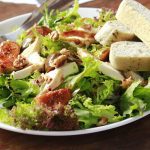Get The Most Out of Your Figs from Backyard Eats
Harvesting Figs
When It’s Ready
- Observe the color and texture: Ripe figs will have a deep, rich color and a slightly soft texture.
- Check for a drooping posture: Figs that are ready for harvest will bend downward rather than pointing upwards.
- Assess the fruit’s firmness: Gently squeeze the fig, and it should yield slightly but not be too mushy.
- Late summer to fall, typically from August to October
When It’s Too Late
- Overripe figs become overly soft, mushy, and may start to ooze or ferment.
- Regularly check your fig tree to ensure you pick the figs at their peak ripeness.
How To
- Wear gloves to protect your hands from the milky sap some fig trees produce.
- Hold the fig near its base and give it a gentle twist. Ripe figs should detach easily from the tree.
- Place the harvested figs gently in a container, taking care not to crush them.
- Avoid leaving figs in direct sunlight for extended periods as they can quickly become overripe.
- Freshly harvested figs have a short shelf life, so enjoy them promptly.
About Figs
Figs are shrubs that grow 5-15 ft tall. They require full sun, trellising, and pruning to thrive.
Flowering/Fruiting Tendencies
Figs are an unusual fruit with no visible flower. Figs can also, uniquely, fruit during their first year. Young fruitlets will start to form along branches in summer and mature in fall.
Design Notes
Figs can get very big – up to15 feet if they are happy and allowed to grow wild. Figs can also handle heavy pruning and can be kept in a nice 8 x 8 space. They are prone to winter die back and are happiest against a south facing wall, where it’s hot and dry.
Care Notes
During the first couple years at least, figs should be covered over the winter to limit winter injury and die off. Coverage typically entails the creation of a system to hold insulating material like leaves or straw. In some cases, figs can die back to the ground and still survive to grow and fruit the following year. Many gardeners with mature plants even cut them down to a stump every year so they stay small and manageable. Figs should be pruned to remain accessible to the harvester and can be kept to eight leaders. When not pruned and crowded, figs will grow small fruit that will be less likely to ripen.
Newly planted perennials require some additional care to help establish and support the plants as they grow. Water newly planted perennials deeply at the root 2-3 times a week during the first growing season. Apply compost and wood chip mulch in the late winter/early spring.
Storing Figs
Fresh Storage: Place fresh figs in a single layer in a breathable container, like a shallow bowl, and store them in the refrigerator for up to five days.
Long-Term Storage: Figs can be dried by cutting them in half, laying them on a baking sheet, and drying them in the oven on low heat until they are fully dried. You can also use a specialized food dehydrator. Store dried figs in an airtight container in a cool, dark place for several months.

Cooking With Figs
- Fresh Fig Salad: Slice fresh figs and combine them with mixed greens, goat cheese, toasted nuts, and a balsamic vinaigrette. The sweet and luscious figs add a delightful contrast to the salad.
- Fig and Prosciutto Crostini: Spread goat cheese or cream cheese on toasted baguette slices, then top with thinly sliced fresh figs and a piece of prosciutto. This combination of sweet, salty, and creamy flavors creates a delicious appetizer.
- Fig Jam: Simmer figs with sugar, lemon juice, and a touch of water until they break down and form a thick jam. Enjoy the homemade jam on toast, cheese boards, or as a filling for pastries.
- Roasted Fig Dessert: Halve fresh figs and roast them in the oven with a drizzle of honey and a sprinkle of cinnamon until they soften and caramelize. Serve the roasted figs with a dollop of yogurt or ice cream for a simple yet elegant dessert.
- Fig and Cheese Pairings: Serve fresh figs alongside a selection of cheeses like Brie, Gorgonzola, or Camembert. The combination of the sweet figs and creamy, tangy cheeses creates a delightful flavor contrast.
- Fig and Almond Tart: Arrange fresh fig slices on a pre-baked tart shell, then pour a sweet almond custard over them. Bake until the tart is golden and the filling is set for a decadent dessert.
- Fig Chutney: Cook diced figs with onions, vinegar, brown sugar, and a combination of warm spices like ginger, cinnamon, and cloves. This sweet and savory chutney pairs well with cheese, roasted meats, or as a condiment for sandwiches.




